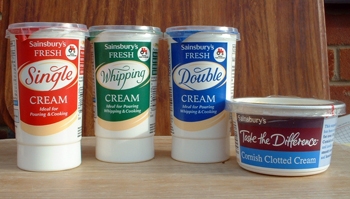
© Denzil Green
Cream is essentially butterfat suspended in the more watery milk around it.
We think of Cream as being “heavier” than milk because mentally we think about what the fat content can do to us, but it is actually lighter than milk, which is why Cream will rise to the top.
Cream can be separated from milk in two ways.
The first is through letting gravity do its work. Cream, being lighter than milk, will rise to the top where it can be skimmed off by hand. (What happens is fat globules cluster together, pushing out the heavier water molecules, forming lighter clusters of Cream.) Obviously, this is too slow a process for commercial production.
The second way, as brutal as it sounds, is by using centrifugal force. Whole milk is preheated to above 122 F (50 C), to loosen its elements up a bit. Then, it is fed down a tube into a whizzing separator bowl that rotates about 5,400 times a minute. The Cream gravitates towards the centre and the milk rises up the slides and out through holes.
The Cream is then pasteurized, then rapidly cooled to about 40 F (4 or 5 C.) It may also be homogenized, sterilized and/or ultra-heat treated.
North American and British Cream Categories
Butterfat %Type of Cream55
Clotted48
Double36
Heavy30 – 40
Crème fraîche35
Whipping30 – 35
Light Whipping18
Table (aka Single or Coffee Cream)18
Sour Cream12
Half & HalfIn Switzerland, the cream types are as follows:
Butterfat %Type of Cream45
Double (Doppelrahm)35
Full Cream / Whipping Cream (Vollrahm/Schlagrahm)25
Half Cream (Halbrahm)15
Coffee Cream (Kaffeerahm)35
Sour Cream (Sauerrahm)15
Half-fat Sour Cream (Saurer Halbrahm)
Cooking Tips
In Cream, because the protein is so surrounded by fat globules, the protein is less likely to coagulate when heated than milk, or when acids such as that from lemons or vegetables are added. This makes Cream resistant to coagulating — or curdling, and therefore a favourite item for making sauces with.
-
- For salad dressings, use Half Cream, Sour Cream or Crème Fraîche;
- For floating on coffee, use Double Cream or lightly-whipped Whipping Cream
- For putting over fruit or fruit pies or desserts, try Sour Cream, Clotted Cream, Crème Fraîche or Extra Thick Single or Double Cream.
Substitutes
Per cup of Heavy Cream, in something to be cooked: ½ cup butter plus ¾ cup milk;
-
- Per cup of Light Cream, in something to be cooked; 1 cup liquid with 1 tablespoon flour;
- Milk, if you thicken the dish you are making with something else such as a starch thickener or puréed veg.
- Crème Fraîche, Sour Cream, Greek Yoghurt
Nutrition
Cream contains butterfat, and small amounts of lactose (a sugar in milk), minerals, vitamin and protein.
Storage Hints
Do not freeze Coffee Cream, or Half and Half Cream. They will separate upon thawing and curdle when poured into hot coffee. You can freeze a higher-fat Cream, such as Whipping Cream.
History Notes
In 1878, the Swedish inventor Gustav de Laval designed the first machine to separate Cream from milk by centrifugal force.
Literature & Lore
“Now the profits arising from Milk are chiefly three; viz Cream, Butter, and Cheese; the Cream is the very heart and strength of the Milk, which must be skimmed very cleanly: Cleanly, I say, for Cleanliness is such an ornament to a good Huswife, that if she want any part thereof, she loseth both that and all other good names whatsoever. Cream is not to be kept above two days in Summer, and not above four in the Winter, if you wil be alwayes provided with the best and sweetest Butter.”
— Hannah Woolley. The Gentlewomans Companion. London. 1673.
Language Notes
Called “Uachder” in Scots Gaelic.

